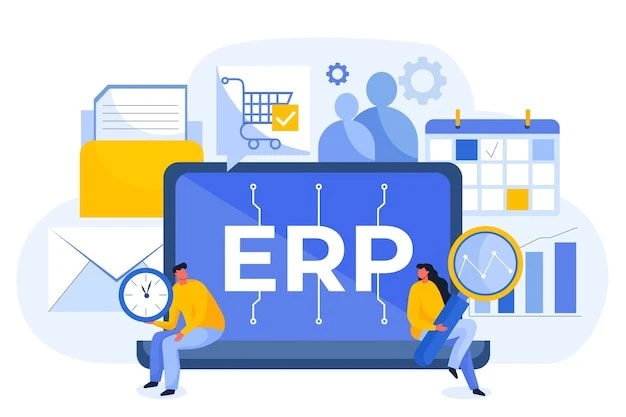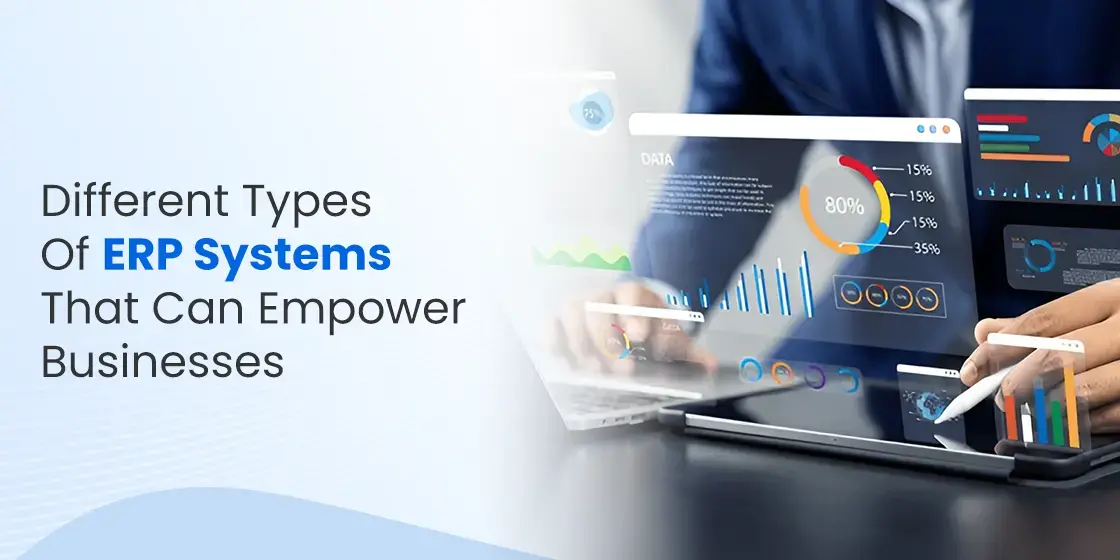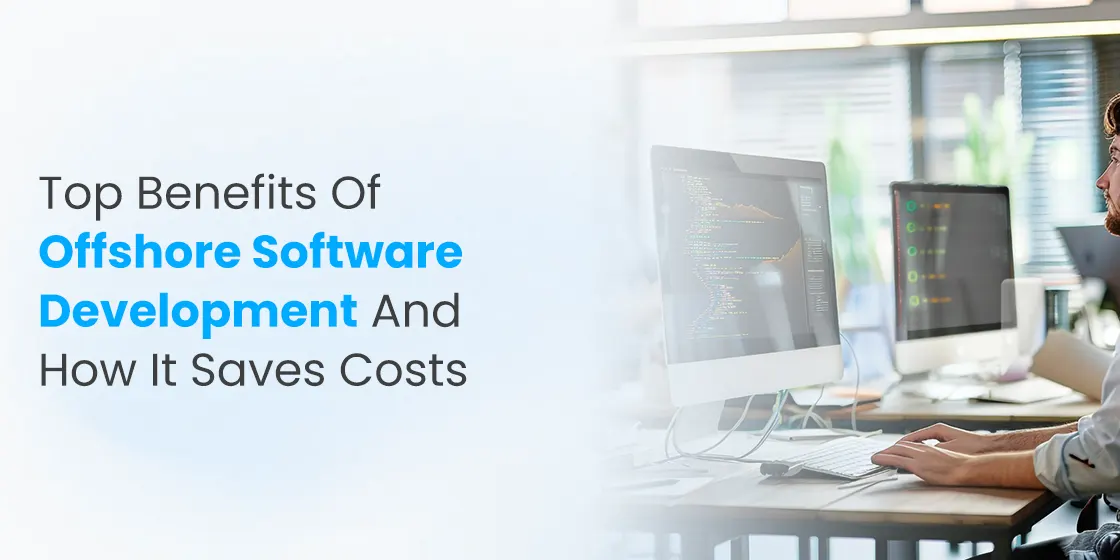Table of Content
Discover How the Different Types of ERP Systems Can Help Your Business Succeed
For today’s interconnected business environment, the ability to efficiently manage and integrate core processes is essestial for achieving sustainable growth and maintaining a competitive edge. Enterprise Resource Planning (ERP) systems have emerged as indispensable technological solutions that allow organizations to centralize data, automate workflows, and gain comprehensive visibility across various operational areas. These include finance, human resources, manufacturing, supply chain, and customer relationship management, and more.
By providing a unified platform for managing these critical functions, ERP systems empower businesses to make data-driven decisions, optimize resource allocation, and enhance overall efficiency. However, developing the different types of ERP systems is not so simple; rather, it requires various elements, each offering distinct pros and cons for different business needs, infrastructure capabilities, and strategic priorities.
Therefore, your choice of ERP system type is a significant strategic decision that can impact your business’s operational agility, IT infrastructure, and long-term growth. Let’s explore the four types of ERP systems, their core features, benefits, drawbacks, and ideal use cases for enterprise software development services to help you make an informed decision.
Defining Enterprise Resource Planning Software Systems

At its core, an Enterprise Resource Planning (ERP) system is an integrated software suite that manages and automates a business’s core processes. It acts as a central hub, consolidating data from various departments and functions into a single, unified database. This integration eliminates information silos, promotes collaboration, and provides a holistic view of the organization’s operations. ERP systems typically comprise various modules that address specific business areas, such as:
- Financial Management: Includes general ledger, accounts payable, accounts receivable, budgeting, forecasting, and financial reporting.
- Human Capital Management (HCM): Covers payroll, benefits administration, talent management, workforce planning, and HR analytics.
- Supply Chain Management (SCM): Encompasses inventory management, procurement, warehouse management, transportation management, and demand planning.
- Manufacturing: Includes production planning, shop floor control, quality management, and material requirements planning (MRP).
- Customer Relationship Management (CRM): Manages sales, marketing, customer service, and customer data.
The primary objective of an ERP system is to improve operational efficiency, enhance decision-making, and foster better communication across the organization. By centralizing data and automating routine tasks, ERP systems reduce manual errors, streamline workflows, and free up employees to focus on more strategic initiatives.
The evolution of ERP systems has been significant, moving from early mainframe-based solutions to more flexible and scalable client-server architectures and, most recently, to cloud-based deployments that integrate within the enterprise website development niche. This evolution has broadened the accessibility of ERP systems to businesses of all sizes and complexities.
Modern ERP systems often incorporate advanced technologies such as artificial intelligence (AI), machine learning (ML), and the Internet of Things (IoT) to further enhance their capabilities and provide even deeper insights into business operations. The ability to choose from various deployment models allows organizations to select the ERP system that best aligns with their specific technical infrastructure, budgetary constraints, and strategic objectives.
Four Types of ERP Systems That Can Be Developed for Businesses
The development and deployment of ERP systems offer businesses a range of options, each with distinct characteristics and implications. Understanding these four primary types is crucial for making an informed decision about which model best suits an organization’s needs.
On-Premises ERP

An on-premises ERP system is characterized by its deployment on a company’s own physical hardware and infrastructure, located within the organization’s premises. The business assumes complete ownership and control over all aspects of the system, including the servers, software, network infrastructure, and data storage. This model often requires a significant upfront investment in hardware and software licenses, as well as ongoing costs for IT staff, maintenance contracts, and potential infrastructure upgrades over time.
One of the primary advantages of an on-premises ERP system is the high degree of control it offers over data security and system customization, allowing for easy enterprise application modernization. Organizations have direct control over who accesses their data and how it is protected, which can be particularly important for businesses operating in highly regulated industries with stringent data privacy requirements. This level of tailoring can be beneficial for companies with highly specialized needs.
However, the significant upfront expenditure associated with hardware and software licenses is a major drawback of on-premises ERP systems. Additionally, the ongoing costs of IT staff, maintenance, and infrastructure upgrades can be substantial and unpredictable. Scalability can also be a challenge, as expanding the system to accommodate growth often requires significant hardware investments and downtime for upgrades.
Get cutting-edge ERP software solutions built according to your business demands. Hire our dedicated teams to build advanced custom products.
Get a QuoteCloud ERP
Cloud ERP systems, in contrast to on-premises deployments, are hosted on the infrastructure of a third-party vendor and accessed by users over the internet. The vendor manages the hardware, software, and underlying infrastructure, freeing the business from these responsibilities.
Cloud ERP solutions operate on a subscription-based model, where businesses pay a recurring fee (typically monthly or annually) for access to the software and infrastructure. The ERP vendor is responsible for maintaining the servers, software updates, security, and overall availability of the system. Users can access the ERP system from anywhere with an internet connection via web browsers or dedicated mobile applications.
This eliminates the need for significant upfront investments in hardware and reduces the burden on the organization’s IT department for ongoing maintenance and infrastructure management. Cloud ERP vendors often offer various service level agreements (SLAs) that guarantee uptime and performance.
Cloud ERP systems offer numerous advantages, including lower upfront costs due to the subscription-based model. Scalability is a key benefit and accessibility is greatly enhanced. The vendor handles system maintenance, security updates, and backups, reducing the workload and resource requirements for the organization’s IT department.
However, some organizations have concerns about data security and vendor lock-in.
Hybrid ERP

A hybrid ERP system combines elements of both on-premises and cloud ERP deployments. Typically, an organization will deploy certain ERP modules or functionalities on its own infrastructure while leveraging cloud-based modules for other areas. This model is one that often causes confusion among newbies as to what is an ERP software system essentially.
In a hybrid ERP model, a business might choose to keep sensitive data or core operational modules on-premises for greater control and security, while deploying less critical modules, such as CRM or certain supply chain functionalities, in the cloud for increased flexibility and accessibility. Integration between the on-premises and cloud components is a critical aspect of a successful hybrid ERP deployment.
Hybrid ERP offers a flexible approach that allows businesses to optimize their ERP deployment based on specific requirements. Organizations can retain control over sensitive data and critical processes by keeping them on-premises while benefiting from the scalability and accessibility of cloud-based modules for other functions. Hybrid ERP can also address specific regulatory or compliance requirements that might necessitate keeping certain data on-premises.
However, the complexity of managing and integrating different ERP modules across both on-premises and cloud environments can be a significant challenge. Ensuring seamless data flow and process integration between these disparate systems requires careful planning and robust integration tools.
Multicloud ERP
A multicloud ERP strategy involves utilizing ERP software and related services from multiple cloud providers. This approach moves beyond a single cloud vendor, distributing ERP workloads and data across different cloud platforms.
In a multicloud ERP deployment, a business might leverage one cloud provider for its core ERP application, another for data analytics and business intelligence, and yet another for disaster recovery or specific module extensions. This strategy aims to avoid vendor lock-in, optimize performance by leveraging the specific strengths of different cloud platforms, and enhance resilience through redundancy across multiple cloud infrastructures.
Leveraging the specialized capabilities of different cloud providers can lead to optimized performance and cost efficiency for various ERP workloads. Multicloud deployments can also enhance business continuity and disaster recovery by providing redundancy across multiple geographically diverse cloud infrastructures. This approach can also support data sovereignty and compliance requirements by allowing organizations to choose cloud providers with data centers located in specific regions.
However, the complexity of managing and integrating ERP components and data across multiple cloud platforms can be challenging. Data synchronization and consistency across different clouds can also be complex. The potential for increased complexity in terms of governance, compliance, cost, and security management necessitates a well-defined multicloud strategy and robust management tools.
Conclusion
The ERP system industry offers a diverse range of deployment models, each with its own set of advantages and considerations. The optimal choice among the different types of ERP systems depends on a thorough evaluation of a business’s specific needs, technical capabilities, budgetary constraints, security requirements, and long-term strategic goals. By carefully considering the characteristics, benefits, and drawbacks of each model, organizations can select the ERP system that best empowers them to streamline operations, enhance decision-making, and achieve sustainable growth in the years to come.
Empower your digital initiatives with BariTechSol, a premier custom software development company. Our skilled team tailors cutting-edge solutions to your unique needs. Elevate your tech experience and stay ahead in the digital realm. Partner with BaritechSol and code the success of your next big idea.


